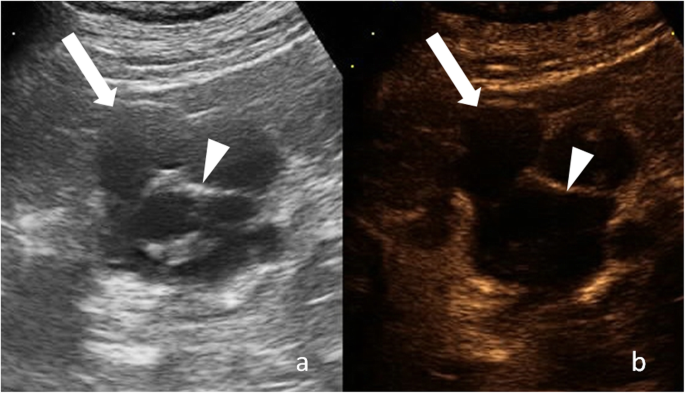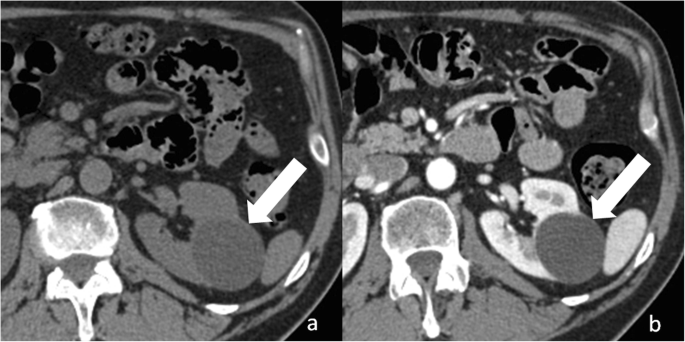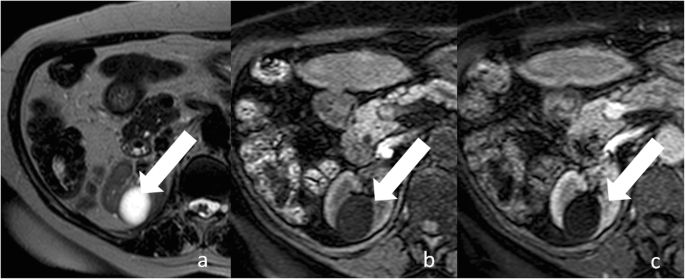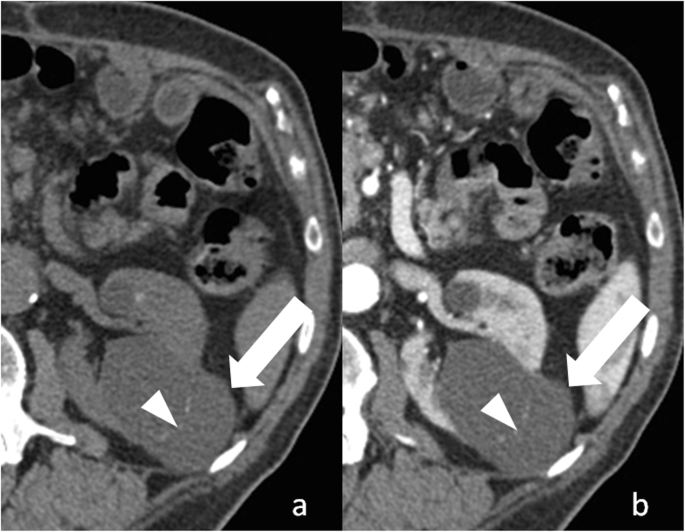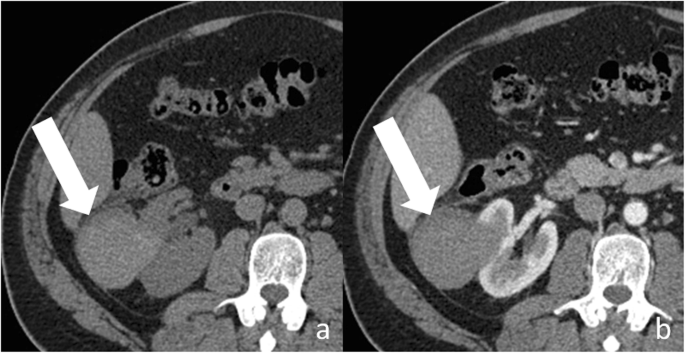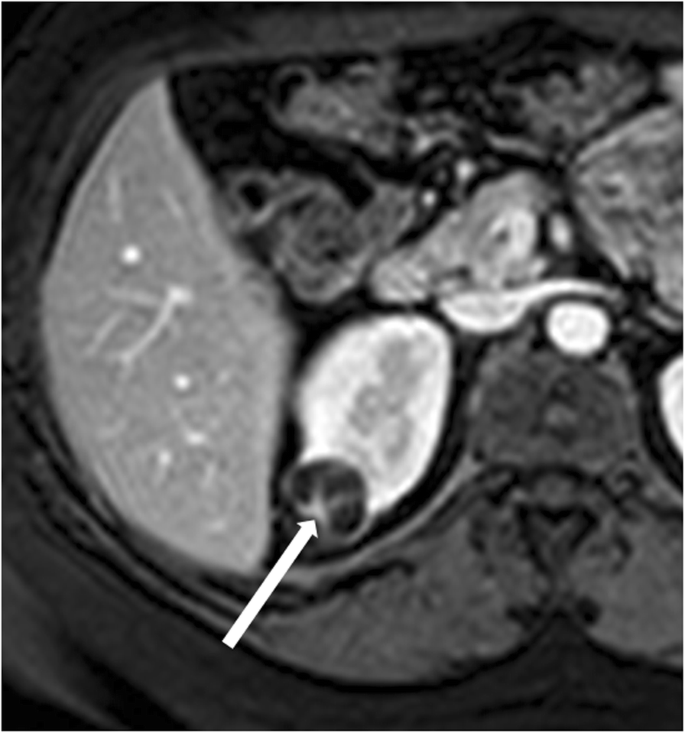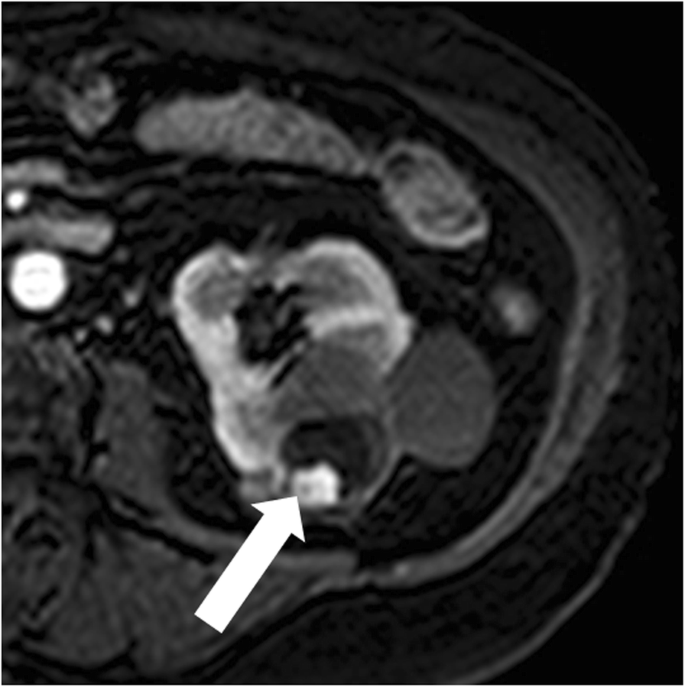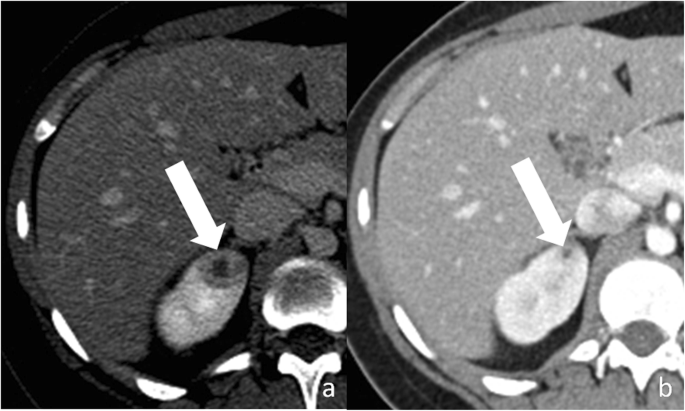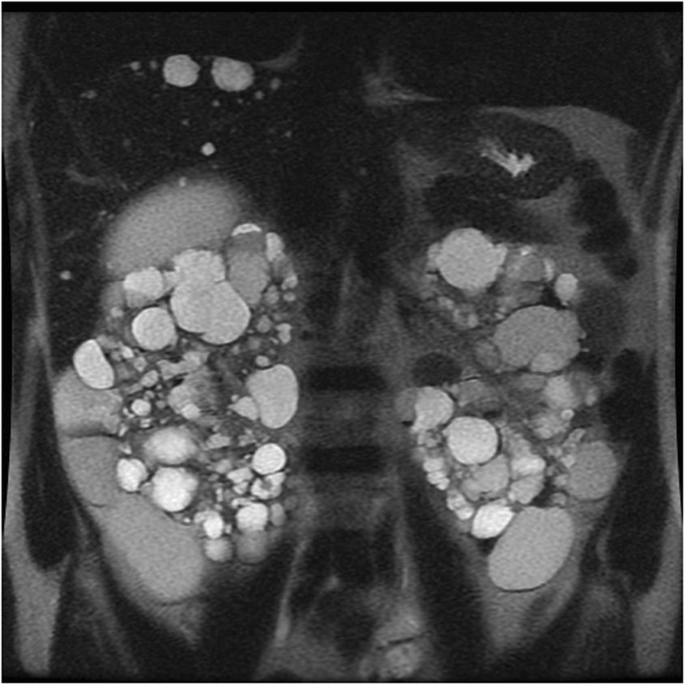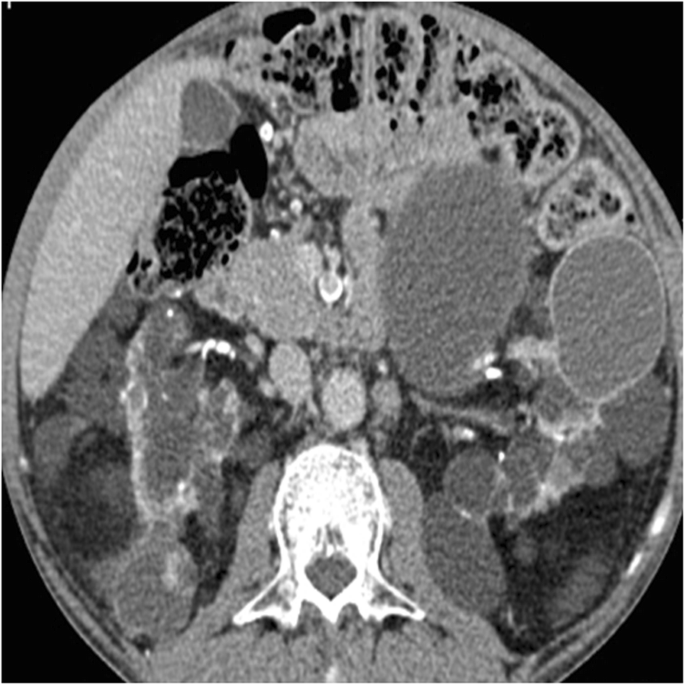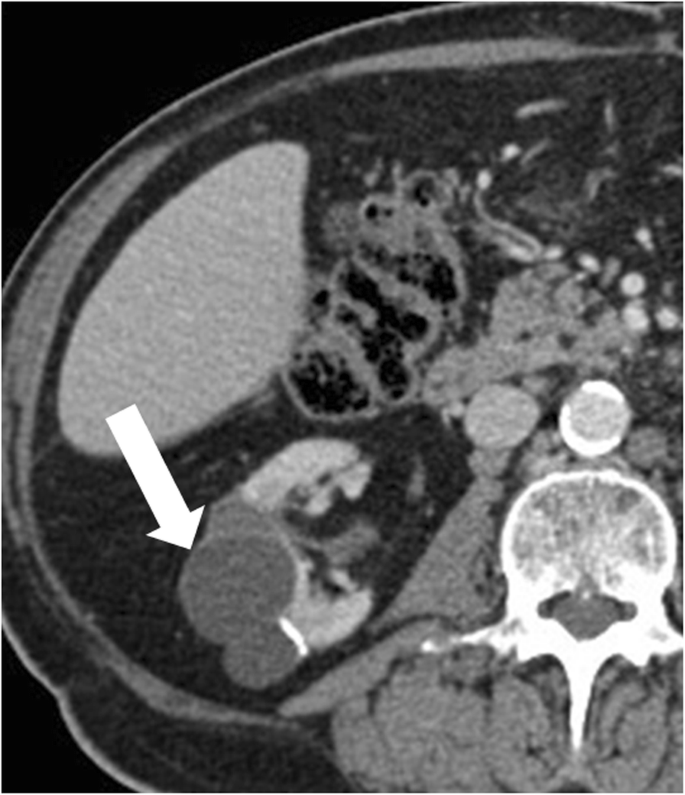- Educational Review
- Open access
- Published:
CT and MR imaging of cystic renal lesions
Insights into Imaging volume 11, Article number: 5 (2020)
Abstract
Cystic renal lesions are a common incidental finding on routinely imaging examinations. Although a benign simple cyst is usually easy to recognize, the same is not true for complex and multifocal cystic renal lesions, whose differential diagnosis includes both neoplastic and non-neoplastic conditions. In this review, we will show a series of cases in order to provide tips to identify benign cysts and differentiate them from malignant ones.
Key points
-
Cystic renal lesions are a common incidental finding on routinely imaging examinations.
-
Benign simple cyst is usually easy to recognize at imaging.
-
Differential diagnosis of complex and multifocal cystic renal lesions include both neoplastic and non-neoplastic conditions.
-
The most widely used system to classify cystic renal lesions was introduced by Bosniak in 1984 and revised in 1997.
-
Renal cysts can be divided into focal and multifocal.
Introduction
Cystic renal lesions are very commonly encountered at abdominal ultrasound, computed tomography (CT), and magnetic resonance (MR) imaging. Most lesions are asymptomatic and incidentally found, but they can rarely manifest with abdominal pain, hematuria, and signs of infection (e.g., fever). Although the majority represents simple cysts, their pathologic spectrum is broad and includes developmental, neoplastic, and inflammatory processes.
Ultrasound represents usually the first-line imaging examination of the abdomen and kidney and can easily recognize simple, fluid-filled renal cysts with the following criteria: homogeneous anechoic content, marked posterior enhancement, and well-defined borders [1, 2].
When these criteria are absent, a cystic renal lesion is classified as a complex cyst [1, 2].
The term “complicated cyst” must be reserved to those cysts, which undergo morphological changes due to documented rupture, hemorrhage, or infection [1, 2]. Complex and complicated renal cysts cannot be accurately characterized at ultrasound and usually warrant contrast-enhanced CT or magnetic resonance (MR) imaging [1, 2]. Because of absence of ionizing radiation and low-cost contrast-enhanced US (CEUS) is emerging as a valuable alternative to contrast-enhanced CT and MR [3, 4]. A growing body of evidence suggests that CEUS is useful to evaluate the vascularity of both cystic renal and hepatic lesion in real time using microbubble-based, purely intravascular, contrast agents (Fig. 1) [3,4,5,6,7]. However, the use of CEUS hampered operator dependency and technical limitations due to deep lesion location, bowel interposition, patient body habitus, and patient cooperation [3, 8]. Knowledge of the imaging characteristics and understanding the pathophysiology of cystic renal lesions helps the radiologist to derive the correct diagnosis.
A useful strategy for the evaluation of renal cysts is to divide them into focal and multifocal.
In this paper, we will expose radiologists to a series of CT and MRI cases in order to provide tips to identify benign cysts and differentiate them from malignant ones in adult patients.
CT or MRI: advantages and disadvantages
Contrast-enhanced CT is the modality of choice in evaluating cystic renal masses. Narrow detector thickness (< 1 mm) and intravenous administration of contrast agent are mandatory to detect thin septa and small enhancing nodules [9]. Also, demonstration of enhancing areas helps differentiate solid components from hemorrhage or debris [10]. MRI is used when CT is contraindicated (e.g., patients with allergy to iodinated contrast agent) or as a problem-solving modality for equivocal findings. Indeed, MRI can show some septa that are less apparent at CT and demonstrate definitive enhancement in those cysts that show only equivocal enhancement at CT [11]. As a consequence, renal cysts can be placed in a higher Bosniak category with MRI than with CT [11].
Focal renal cysts
Focal renal cysts are common in older subjects. Their prevalence, size, and number increase with age, with approximately 30% of people after the fourth decade and 40% after the fifth decade having at least one renal cyst [12, 13]. The majority is benign simple renal cysts and can be diagnosed with confidence. However, cystic renal lesions can have benign as well as malignant causes. Possible malignant causes include renal cell carcinoma (RCC) and metastasis. Since cystic RCCs, benign complicated cysts, and other cystic tumors can be radiologically indistinguishable, the goal of imaging when a renal cyst is found is to differentiate a benign “leave-alone” lesion from a lesion that requires treatment.
Bosniak classification system for renal cysts
The most widely used system to classify cystic renal lesions was introduced by Bosniak in 1984 and revised in 1997 [14, 15]. This system was originally developed on CT findings, but it can be also used at MRI [11, 16, 17].
Renal cysts are divided into five categories on the basis of imaging appearance (Table 1, Fig. 2). Each Bosniak category reflects the likelihood of cystic RCC that ranges from I (simple cyst) to IV (cystic tumors). Category I, II, and, IIF cysts are nonsurgical, while categories III and IV are surgical.
Imaging features of cystic renal lesions according to Bosniak classification. a Bosniak category I cyst: thin wall. b Bosniak category II cyst: thin wall; few, thin septa. c Bosniak category II-F cyst: minimally thickened wall; several, minimally thickened septa. d Bosniak category III cyst: irregularly thickened wall; several, irregularly thickened septa. e Bosniak category IV cyst: enhancing nodularity; irregularly thickened wall; several, irregularly thickened septa
Imaging findings include attenuation/signal intensity, size, presence of calcifications, septa and enhancing nodularity. Among these, enhancing nodularity is considered the most important predictor of malignancy [18]. At CT, enhancement requires an increase of attenuation of at least 15–20 HU from unenhanced to the contrast enhanced images [18]. A 10–15 HU change in attenuation can be due to incorrect placement of the region of interest, patient motion, or beam hardening from adjacent enhancing renal parenchyma (the so called “pseudoenhancement”) [19]. To overcome this problem, it has been suggested to use dual-energy CT, where true unenhanced images can be replaced by virtual unenhanced images [20]. Iodine quantification and iodine-related attenuation are used to differentiate nonenhancing cysts from enhancing solid masses [20].
In equivocal cases, another option is to use subtraction MRI to assess the presence or absence of enhancement [21].
Septa are defined as dividing wall within a renal cyst and are best appreciated at MRI than at CT. When present, they can be classified as thin, minimally thickened, or grossly thickened and irregular, and as enhancing or non-enhancing.
Calcifications are usually easy to recognize at CT but may be unapparent at MRI. Despite the importance in predicting the malignancy of solid renal masses, calcifications have limited utility in the Bosniak classification since they can be found in the wall or septa of both benign and malignant cysts [22]. Similarly, the size does not reliably predict the benignity or malignity of a renal cyst. Indeed, larger cysts can be benign and small ones can be malignant.
Category I renal cysts
Category I cysts are simple benign cysts. The exact pathogenesis is unknown. It has been suggested that they originate from weakening of the basement membrane of distal convoluted or collecting tubules [23]. Imaging appearance is consistent with water content: 0–20 HU attenuation on unenhanced CT, strong hyperintensity on T2-weighted MRI sequences, hypointensity on T1-weighted MRI sequences (Figs. 3 and 4). The wall is thin, hair-line, and non-enhancing. Calcifications, septa, and enhancing nodularity are absent. Almost all are benign. In a study including 1700 individuals with at least one renal cyst, only two patients developed a renal neoplasm [12]. Category I renal can grow in size over time. Treatment or follow-up are not recommended.
Category II renal cysts
Category II renal cysts are slightly more complicated in that they show hair-line wall, and few, thin septa, which can show perceived (not measurable) enhancement (Fig. 5). Fine calcifications or a short segment of slightly thickened calcifications can be present in the wall or septa. Complicated (proteinaceous or hemorrhagic) renal cysts measuring less than 3 cm are also included in the category II. These cysts show hyperattenuation (> 20 HU) on unenhanced CT, high signal intensity on unenhanced T1-weighted MRI sequences, and no enhancement, which helps differentiate benign cyst from RCC. Lesion homogeneity and smooth borders also are highly suggestive of a benign cyst [24]. In general, proteinaceous cysts measure 20–40 HU and are anechoic at ultrasound, while hemorrhagic cysts measure over 40 50 HU and can show a complex appearance at ultrasound [25]. Category II renal cysts are benign, and do not require treatment or follow-up.
Category IIF renal cysts
Category IIF renal cysts (“F” means follow-up) are more worrisome than category I and II [15, 26, 27]. The wall and septa can show minimal thickening and perceived (not measurable) enhancement and can contain irregular or nodular calcifications (Fig. 6). Unlike category II cysts, they can contain several septa. Complicated renal cysts measuring more than 3 cm are included in the category IIF (Fig. 7). Category IIF renal cysts are benign in 75–95% of time [28,29,30]. Imaging follow-up is required to exclude the malignancy by showing stability over time. However, the optimal interval time for follow-up is unclear and is influenced by cyst complexity. Bosniak had suggested that category IIF cysts with minimal complications need a 1–2-year follow-up, while more complex ones require at least a 3–4 year follow-up [31].
Category III renal cysts
Category III renal cysts are indeterminate lesions with a reported malignancy of nearly 50% [28]. This category includes multilocular cysts, hemorrhagic and infected cysts, multilocular cystic nephroma, and cystic RCC [32]. Wall and septa are irregularly thick, show a measurable enhancement, and can contain thick nodular calcifications (Fig. 8). Septa are increased in number compared to category II cysts. Surgical removal of category III renal cysts is recommended because of their increased risk of malignancy.
Category IV renal cysts
Category IV renal cysts are considered malignant lesions. Nearly all are RCCs or, more rarely, metastases [32]. However, there are few benign lesions such as mixed epithelial and stromal tumor (MEST) and cystic angiomyolipomas that can be classified as category IV renal cysts [32]. The hallmark of this category is the presence of enhancing nodularity (Fig. 9). These cysts can also contain all findings observed in category III. Surgical removal is strongly recommended.
Cystic renal cell carcinoma
Cystic RCC is relatively rare and comprises approximately 3–15 % of all cases of RCCs. It is found more commonly in younger age and in females compared with solid RCC [33]. The cystic appearance can be related to their inherent architecture or secondary to cystic degeneration and extensive necrosis [34]. Clear cell type RCC is the most common subtype, followed by papillary and chromophobe RCC. Clear cell type RCC can show a dominant cystic component or can arise in a simple cyst [35]. Multilocular cystic RCC of low malignant potential is a rare variant of clear cell type RCC with no reported recurrence or metastasis. This tumor is composed exclusively by cysts with low-grade tumor cell [36] and shows a variable imaging appearance, which ranges from category IIF to category IV renal cysts [35]. Papillary RCC can appear as a cyst with hemorrhagic or necrotic content and a thick pseudocapsule [35]. Cystic renal RCCs have a more favorable prognosis of all subtypes of RCC: they have a low Fuhrman grade, grow slowly, and rarely metastasize or recur [37].
Renal metastases
Renal metastases are not uncommon, with reported frequencies ranging from 7 to 20% at post-mortem studies [38,39,40,41]. The most common primary malignancies are the lung, breast, gastrointestinal tract, and melanoma. CT and MR imaging diagnosis is less frequent because post-mortem studies included microscopic lesions, which are beyond CT resolution [42, 43].
Renal metastases can show a solid or cystic appearance. The differentiation of renal metastasis from RCC on the basis of CT and MR findings alone may be impossible [42,43,44]. However, some features are likely to be distinctive: renal metastases are frequently multiple, bilateral and small [42, 43].
Mixed epithelial and stromal tumors
The MESTs area heterogeneous group of rare renal tumors occurring predominantly in perimenopausal women (female-to-male ratio, 11:1). The MEST appears as a well-marginated lesion with a variable proportion of solid and cystic components [45]. Septa and nodules can show heterogeneous and delayed enhancement [45]. MEST can show an exophytic growth or herniate into the renal pelvis [45]. Adult cystic nephroma is now classified within MEST family due to similar histologic and epidemiologic findings [36]. This tumor appears as an encapsulated lesion, with cysts of variable size, and thin, variably enhancing, septa [46]. Calcifications are peripheral and curvilinear [46]. Solid components are typically absent [46]. At MRI, the capsule and septa can show hypointensity on both T1- and T2-weighted images due to the fibrous composition. Since imaging features are non-specific, differentiation between MEST and cystic RCC requires pathologic examination.
Renal abscess
Renal abscess is an uncommon entity that usually results from a complication of untreated or inadequately treated acute pyelonephritis or ascending urinary tract infection. More rarely, it results from hematogenous spread from an extra-urinary source of infection (e.g., diverticulitis, pancreatitis). Patients may present with signs and symptoms of infection. Renal abscess can appear as a complex renal cyst with inhomogeneous areas of fluid attenuation/intensity and a thick and irregular wall that shows a little enhancement on excretory phase (Fig. 10). Because of the presence of viscous pus, the fluid component shows a characteristic strong and heterogeneous diffusion restriction on diffusion-weighted imaging, which favors the diagnosis of renal abscess over that of RCC [47]. Renal parenchyma around the abscess can show low density/intensity on early phases and delayed enhancement [48, 49]. Fat stranding is often found adjacent to the renal abscess [50]. Gas can be rarely present within the lesion and strongly suggests abscess formation. When imaging findings, clinical history and laboratory tests do not permit a confident differentiation between renal abscess and cystic RCC; biopsy/drainage should be performed to obtain the correct diagnosis.
Multifocal renal cysts
Multifocal cystic renal diseases comprise a heterogeneous spectrum of hereditary and nonhereditary diseases characterized by the presence of multiple simple kidney cysts [32]. Hereditary entities are due to mutations of genes involved in the formation and functioning of renal cilia, which result in epithelial proliferation and development of renal cysts [51]. Autosomal dominant polycystic kidney disease is the most common hereditary multifocal renal disease. Nonhereditary entities are due to obstructive, stromal-epithelial malinductive and neoplastic mechanisms [52]. Most common causes of nonhereditary multifocal cysts formation include lithium-induced nephrotoxicity, acquired cystic renal disease, and localized cystic renal disease. The location and appearance of renal cysts, presence of interposed normal renal parenchyma, size of the kidneys, patient’s age at presentation, and degree of renal function help differentiate at imaging multifocal cystic renal diseases.
Autosomal dominant polycystic kidney disease
Autosomal dominant polycystic kidney disease (ADPKD) is the most common hereditary renal disorder and occurs in approximately one of 500 live births [51]. Mutations in one of the two genes encoding plasma membrane—spanning polycystin 1 and polycystin 2 (PKD1 and PKD2)—are responsible of the disease. It is characterized by progressive development and growth in size of simple renal cysts, leading to symmetric enlargement of the kidneys and chronic renal failure by late middle-age [52, 53] (Fig. 11). Cysts have variable dimension (from few millimeters to several centimeters) and are diffusely distributed through the kidneys. Cyst complications include hemorrhage, pyogenic infection, and, more rarely, rupture. The risk for RCC is not increased in comparison with the general population except in patients on dialysis [54]. The added risk of malignancy in dialysis patients is probably related to the effects of coexistent acquired cystic renal disease [54].
Hepatic cysts are the most common extra-renal manifestations of ADPKD and show variable number, size, location, and distribution [51, 54]. Polycystic liver disease is uncommon and leads to hepatomegaly [51, 54]. More rare hepatic complications include congenital hepatic fibrosis and segmental dilatation of biliary tract [54].
The other extra-renal manifestations of ADPKD include cysts in other organs such as pancreas and non-cystic abnormalities such as cardiac valvulopathies and intracranial aneurysms [51]. Imaging plays a crucial role in the identification of ADPKD in high-risk individuals (those with a positive family history). The diagnosis of ADPKD requires at least three renal cysts (unilateral or bilateral) in high-risk patients 15–39 years of age, at least two cysts in each kidney in high-risk patients 40–59 years of age, and several bilateral renal cysts in high-risk patients 60 years of age or older [55]. Since renal enlargement correlates with a decline of renal function, estimation of renal volume can predict the risk for renal failure [53].
Acquired cystic renal disease
Acquired cystic kidney disease (ACKD) is a consequence of sustained uremia in patient with end-stage renal disease [52]. The disease is found in 8–13% patients with end-stage renal disease and in approximately 50% patients on dialysis. The disease is multifactorial. It is the progressive destruction of renal functioning nephrons with compensatory hypertrophy of remaining renal parenchyma, obstruction of renal tubules by interstitial fibrosis or oxalate crystals, and cyst formation [52]. Kidneys are atrophic and contain multiple cysts with variable size (from few millimeters to several centimeters) and imaging appearance (Fig. 12). Since renal cysts are extremely common in the adult population, the diagnosis of ACKD requires the presence of three or more cysts in each kidney, in conjunction to end-stage renal disease, and no history of hereditable renal disease [56]. Cyst hemorrhage is a common complication and can cause hematuria, whereas cyst rupture, perinephric hematoma, and retroperitoneal hemorrhage are less frequent [52]. Development of RCC in the wall of the cyst is the most serious complication of ACKD, with a higher rate in comparison to the general population [55].
The most common tumor type in patients with ACKD is acquired cystic disease (ACD)-associated RCC, followed by papillary and clear cell type RCC [36]. ACD-associated RCC has unique morphologic features and is found exclusively in patients with end-stage renal disease and ACKD [36].
Lithium-induced nephropathy
Long-term lithium therapy is a well-known cause of nephrotoxicity in the form of polyuria-polydipsia syndrome (diabetes insipidus) and chronic renal insufficiency [57]. Characteristic imaging findings include normal or slightly decreased size of kidneys with multiple, uniformly, and symmetrically distributed microcysts [58]. Microcysts measure 1–2 mm in diameter and are located in both cortex and medulla [58].
Localized cystic renal disease
Localized cystic renal disease is a rare, nonhereditary, form of cystic renal disease, which manifests as a conglomeration of multiple simple cysts of variable size [59] (Fig. 13). In contrast to ACKD and ADPKD, localized cystic renal disease is typically unilateral and not progressive. The disease usually involves only a portion of the kidney with a polar predilection [59]. Entire renal involvement is rare [58]. The contralateral kidney is normal. The presence of interposed normal renal parenchyma and the absence of a capsule help to differentiate localized cystic renal disease from cystic nephroma and multiloculated cystic RCC [58]. Cystic involvement of other organs is typically absent [58].
Conclusions
Cystic renal lesions are commonly encountered on radiologic examinations. Complex and multifocal cystic renal lesions are often a diagnostic challenge, since they can represent neoplastic and non-neoplastic conditions. The Bosniak classification system is a well-established imaging method, which helps radiologists and surgeons in daily practice in the differentiation of nonsurgical from surgical lesions. Radiologists should also recognize the imaging appearances of specific types of cystic lesions in order to better characterize them.
Availability of data and materials
Not applicable
Abbreviations
- ACKD:
-
Acquired cystic kidney disease
- ADPKD:
-
Autosomal dominant polycystic kidney disease
- CEUS:
-
Contrast-enhanced US
- CT:
-
Computed tomography
- MESTs:
-
Mixed epithelial and stromal tumors
- MRI:
-
Magnetic resonance imaging
- RCC:
-
Renal cell carcinoma
References
Hartman DS, Choyke PL, Hartman MS (2004) From the RSNA refresher courses: a practical approach to the cystic renal mass. Radiographics 24(Suppl 1):S101–S115 PMID: 15486234
Hélénon O, Crosnier A, Verkarre V, Merran S, Méjean A, Correas JM (2018) Simple and complex renal cysts in adults: classification system for renal cystic masses. Diagn Interv Imaging 99(4):189–218. https://doi.org/10.1016/j.diii.2017.10.005 PMID: 29482969
Park BK, Kim B, Kim SH, Ko K, Lee HM, Choi HY (2007) Assessment of cystic renal masses based on Bosniak classification: comparison of CT and contrast-enhanced US. Eur J Radiol 61(2):310–314 PMID: 17097844
Ascenti G, Mazziotti S, Zimbaro G et al (2007) Complex cystic renal masses: characterization with contrast-enhanced US. Radiology 243(1):158–165 PMID: 17392251
Corvino A, Catalano O, Corvino F, Sandomenico F, Petrillo A (2017) Diagnostic performance and confidence of contrast-enhanced ultrasound in the differential diagnosis of cystic and cysticlike liver lesions. AJR Am J Roentgenol 209(3):W119–W127. https://doi.org/10.2214/AJR.16.17062
Corvino A, Catalano O, Setola SV, Sandomenico F, Corvino F, Petrillo A (2015) Contrast-enhanced ultrasound in the characterization of complex cystic focal liver lesions. Ultrasound Med Biol 41(5):1301–1310. https://doi.org/10.1016/j.ultrasmedbio.2014.12.667
Corvino A, Sandomenico F, Setola SV, Corvino F, Tafuri D, Catalano O (2019) Morphological and dynamic evaluation of complex cystic focal liver lesions by contrast-enhanced ultrasound: current state of the art. J Ultrasound 22(3):251–259. https://doi.org/10.1007/s40477-019-00385-2
Quaia E, Bertolotto M, Cioffi V et al (2008) Comparison of contrast-enhanced sonography with unenhanced sonography and contrast-enhanced CT in the diagnosis of malignancy in complex cystic renal masses. AJR Am J Roentgenol 191(4):1239–1249. https://doi.org/10.2214/AJR.07.3546
Johnson PT, Horton KM, Fishman EK (2010) Optimizing detectability of renal pathology with MDCT: protocols, pearls, and pitfalls. AJR Am J Roentgenol 194(4):1001–1012. 20308503. https://doi.org/10.2214/AJR.09.3049
Israel GM, Bosniak MA (2005) How I do it: evaluating renal masses. Radiology 236(2):441–450 PMID: 16040900
Israel GM, Hindman N, Bosniak MA (2004) Evaluation of cystic renal masses: comparison of CT and MR imaging by using the Bosniak classification system. Radiology 231(2):365–371 PMID: 15128983
Terada N, Arai Y, Kinukawa N, Terai A (2008) The 10-year natural history of simple renal cysts. Urology 71(1):7–11. https://doi.org/10.1016/j.urology.2007.07.075 PMID: 18242354
Carrim ZI, Murchison JT (2003) The prevalence of simple renal and hepatic cysts detected by spiral computed tomography. Clin Radiol 58(8):626–629 PMID: 12887956
Bosniak MA (1986) The current radiological approach to renal cysts. Radiology 158(1):1–10 PMID: 3510019
Bosniak MA (1997) The use of the Bosniak classification system for renal cysts and cystic tumors. J Urol 157(5):1852–1853 PMID: 9112545
Balci NC, Semelka RC, Patt RH et al (1999) Complex renal cysts: findings on MR imaging. AJR Am J Roentgenol 172(6):1495–1500 PMID: 10350279
Israel GM, Bosniak MA (2005) An update of the Bosniak renal cyst classification system. Urology 66(3):484–488 PMID: 16140062
Benjaminov O, Atri M, O'Malley M, Lobo K, Tomlinson G (2006) Enhancing component on CT to predict malignancy in cystic renal masses and interobserver agreement of different CT features. AJR Am J Roentgenol 186(3):665–672 PMID: 16498093
Galia M, Albano D, Bruno A et al (2017) Imaging features of solid renal masses. Br J Radiol 90(1077):20170077. https://doi.org/10.1259/bjr.20170077 PMID: 28590813
Mileto A, Allen BC, Pietryga JA et al (2017) Characterization of incidental renal mass with dual-energy CT: diagnostic accuracy of effective atomic number maps for discriminating nonenhancing cysts from enhancing masses. AJR Am J Roentgenol 209(4):W221–W230. https://doi.org/10.2214/AJR.16.17325 PMID: 28705069
Fananapazir G, Lamba R, Lewis B, Corwin MT, Naderi S, Troppmann C (2015) Utility of MRI in the characterization of indeterminate small renal lesions previously seen on screening CT scans of potential renal donor patients. AJR Am J Roentgenol 205(2):325–330. https://doi.org/10.2214/AJR.14.13956 PMID: 26204282
Israel GM, Bosniak MA (2003) Calcification in cystic renal masses: is it important in diagnosis? Radiology 226(1):47–52 PMID: 12511667
Baert L, Steg A (1977) Is the diverticulum of the distal and collecting tubules a preliminary stage of the simple cyst in the adult? J Urol 118(5):707–710 PMID: 410950
Davarpanah AH, Spektor M, Mathur M, Israel GM (2016) Homogeneous T1 Hyperintense renal lesions with smooth borders: is contrast-enhanced MR imaging needed? Radiology 281(1):326. https://doi.org/10.1148/radiol.2016164032 PMID:27643777
Silverman SG, Israel GM, Herts BR, Richie JP (2008) Management of the incidental renal mass. Radiology 249(1):16–31. https://doi.org/10.1148/radiol.2491070783 PMID: 18796665
Bosniak MA (1993) Problems in the radiologic diagnosis of renal parenchymal tumors. Urol Clin North Am 20(2):217–230
Bosniak MA (1997) Diagnosis and management of patients with complicated cystic lesions of the kidney. AJR Am J Roentgenol 169(3):819–821
Smith AD, Remer EM, Cox KL et al (2012) Bosniak category IIF and III cystic renal lesions: outcomes and associations. Radiology 262(1):152–160. https://doi.org/10.1148/radiol.11110888 PMID: 22106359
Hindman NM, Hecht EM, Bosniak MA (2014) Follow-up for Bosniak category 2F cystic renal lesions. Radiology 272(3):757–766. https://doi.org/10.1148/radiol.14122908 PMID: 24766033
O'Malley RL, Godoy G, Hecht EM, Stifelman MD, Taneja SS (2009) Bosniak category IIF designation and surgery for complex renal cysts. J Urol. 182(3):1091–1095. https://doi.org/10.1016/j.juro.2009.05.046 PMID: 19616809
Bosniak MA (2012) The Bosniak renal cyst classification: 25 years later. Radiology 262(3):781–785. https://doi.org/10.1148/radiol.11111595 PMID: 22357882
Wood CG 3rd, Stromberg LJ 3rd, Harmath CB et al (2015) CT and MR imaging for evaluation of cystic renal lesions and diseases. Radiographics 35(1):125–141. https://doi.org/10.1148/rg.351130016 PMID: 25590393
Winters BR, Gore JL, Holt SK, Harper JD, Lin DW, Wright JL (2015) Cystic renal cell carcinoma carries an excellent prognosis regardless of tumor size. Urol Oncol 33(12):505.e9–505.13. https://doi.org/10.1016/j.urolonc.2015.07.017 PMID: 26319351
Hartman DS, Davis CJ Jr, Johns T, Goldman SM (1986) Cystic renal cell carcinoma. Urology 28(2):145–153 PMID: 3739121
Moch H (2010) Cystic renal tumors: new entities and novel concepts. Adv Anat Pathol 17(3):209–214. https://doi.org/10.1097/PAP.0b013e3181d98c9d PMID:20418675
Moch H, Cubilla AL, Humphrey PA, Reuter VE, Ulbright TM (2016) The 2016 WHO Classification of tumours of the urinary system and male genital organs-part a: renal, penile, and testicular tumours. Eur Urol 70(1):93–105. https://doi.org/10.1016/j.eururo.2016.02.029 PMID: 26935559
Jhaveri K, Gupta P, Elmi A et al (2013) Cystic renal cell carcinomas: do they grow, metastasize, or recur? AJR Am J Roentgenol 201(2):W292–W296. https://doi.org/10.2214/AJR.12.9414 PMID: 23883243
Meilstrup JW, Mosher TJ, Dhadha RS, Hartman DS (1995) Other renal tumors. Semin Roentgenol 30:168–184
Bracken RB, Chica G, Johncon DE, Luna M (1979) Secondary renal neoplasms: an autopsy study. South Med J 72:806–807
Abrams H, Spira R, Goldstein M (1950) Metastases in carcinoma: analysis of 1000 autopsied cases. Cancer 3:74–85
Klinger ME (1951) Secondary tumors of the genitourinary tract. J Urol 65:144–153
Patel U, Ramachandran N, Halls J, Parthipun A, Slide C (2011) Synchronous renal masses in patients with a nonrenal malignancy: incidence of metastasis to the kidney versus primary renal neoplasia and differentiating features on CT. AJR Am J Roentgenol 197(4):W680–W686. https://doi.org/10.2214/AJR.11.6518 PMID: 21940540
Choyke PL, White EM, Zeman RK, Jaffe MH, Clark LR (1987) Renal metastases: clinicopathologic and radiologic correlation. Radiology 162(2):359–363 PMID: 3797648
Fan G, Xie YU, Pei X et al (2015) Renal metastasis from cervical carcinoma presenting as a renal cyst: a case report. Oncol Lett 10(5):2761–2764
Moslemi MK (2010) Mixed epithelial and stromal tumor of the kidney or adult mesoblastic nephroma: an update. Urol J 7(3):141–147 PMID: 20845287
Lane BR, Campbell SC, Remer EM et al (2008) Adult cystic nephroma and mixed epithelial and stromal tumor of the kidney: clinical, radiographic, and pathologic characteristics. Urology 71:1142–1148
Goyal A, Sharma R, Bhalla AS, Gamanagatti S, Seth A (2013) Diffusion-weighted MRI in inflammatory renal lesions: all that glitters is not RCC! Eur Radiol 23(1):272–279. https://doi.org/10.1007/s00330-012-2577-0 PMID:22797980
Kawashima A, Sandler CM, Goldman SM (2000) Imaging in acute renal infection. BJU Int 86(Suppl 1):70–79 PMID: 10961277
Papanicolaou N, Pfister RC (1996) Acute renal infections. Radiol Clin North Am 34(5):965–995 PMID: 8784392
Katabathina VS, Kota G, Dasyam AK, Shanbhogue AK, Prasad SR (2010) Adult renal cystic disease: a genetic, biological, and developmental primer. Radiographics 30(6):1509–1523. https://doi.org/10.1148/rg.306105513 PMID: 21071372
Gabow PA (1993) Autosomal dominant polycystic kidney disease. N Engl J Med 329(5):332–342 PMID: 8321262
Choyke PL (2000) Acquired cystic kidney disease. Eur Radiol 10(11):1716–1721 PMID: 11097395
Grantham JJ, Torres VE, Chapman AB et al (2006) Volume progression in polycystic kidney disease. N Engl J Med 354(20):2122–2130 PMID: 16707749
Chauveau D, Fakhouri F, Grünfeld JP (2000) Liver involvement in autosomal-dominant polycystic kidney disease: therapeutic dilemma. J Am Soc Nephrol. 11(9):1767–1775 Review. PubMed PMID: 10966503
Tickoo SK, de Peralta-Venturina MN, Harik LR et al (2006) Spectrum of epithelial neoplasms in end-stage renal disease: an experience from 66 tumor-bearing kidneys with emphasis on histologic patterns distinct from those in sporadic adult renal neoplasia. Am J Surg Pathol 30(2):141–153 PMID: 16434887
Pei Y, Obaji J, Dupuis A et al (2009) Unified criteria for ultrasonographic diagnosis of ADPKD. J Am Soc Nephrol 20(1):205–212. https://doi.org/10.1681/ASN.2008050507
Markowitz GS, Radhakrishnan J, Kambham N, Valeri AM, Hines WH, D'Agati VD (2000) Lithium nephrotoxicity: a progressive combined glomerular and tubulointerstitial nephropathy. J Am Soc Nephrol 11(8):1439–1448 PMID: 10906157
Farres MT, Ronco P, Saadoun D et al (2003) Chronic lithium nephropathy: MR imaging for diagnosis. Radiology 229(2):570–574 PMID: 14595154
Slywotzky CM, Bosniak MA (2001) Localized cystic disease of the kidney. AJR Am J Roentgenol 176(4):843–849 PMID: 11264061
Funding
None
Author information
Authors and Affiliations
Contributions
All authors read and approved the final manuscript.
Corresponding author
Ethics declarations
Ethics approval and consent to participate
Not applicable
Consent for publication
Not applicable
Competing interests
The authors declare that they have no competing interests.
Additional information
Publisher’s Note
Springer Nature remains neutral with regard to jurisdictional claims in published maps and institutional affiliations.
Rights and permissions
Open Access This article is distributed under the terms of the Creative Commons Attribution 4.0 International License (http://creativecommons.org/licenses/by/4.0/), which permits unrestricted use, distribution, and reproduction in any medium, provided you give appropriate credit to the original author(s) and the source, provide a link to the Creative Commons license, and indicate if changes were made.
About this article
Cite this article
Agnello, F., Albano, D., Micci, G. et al. CT and MR imaging of cystic renal lesions. Insights Imaging 11, 5 (2020). https://doi.org/10.1186/s13244-019-0826-3
Received:
Accepted:
Published:
DOI: https://doi.org/10.1186/s13244-019-0826-3
